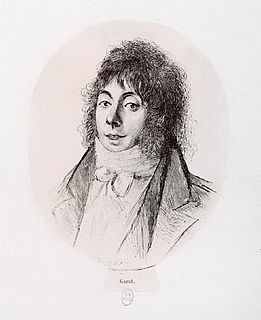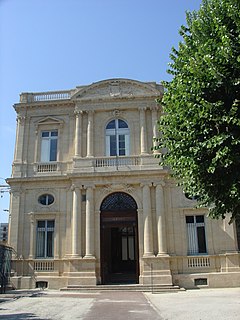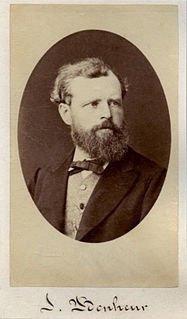

Pierre Lacour, sometimes referred to as "The Younger" (16 March 1778, Bordeaux - 17 April 1859, Bordeaux) was a French painter and engraver.


Pierre Lacour, sometimes referred to as "The Younger" (16 March 1778, Bordeaux - 17 April 1859, Bordeaux) was a French painter and engraver.
His father was the painter Pierre Lacour, sometimes referred to as "The Elder". In 1797, after a private school education, he went to Paris, where he studied with the miniaturist, François-André Vincent. Two years later he returned to Bordeaux and, from 1802 to 1822, created illustrations for the publications of the Société des amis du musée des beaux-arts de Bordeaux . [1] In 1814, upon his father's death, he took over as Curator of the Musée des Beaux-Arts de Bordeaux and Professor at the local drawing school. One of his students was Rosario Weiss Zorrilla; the goddaughter (or as some believe, daughter) of Francisco Goya.
He and Jean-Baptiste Légé (1779-1846) opened a lithography studio in 1821 and, in 1823, he decided to give up painting in favor of engraving. From 1823 to 1825, he worked for the Musée d'Aquitaine. [2] For two years, he had a workshop devoted to the creation of carpets and tapestries.
In 1813, he married Lisidice Combes (1794-1829); daughter of the architect Louis Combes . Politically, his convictions were Royalist, he was an adherent of Saint-Simonianism, and a defender of Neoclassicism. He was especially interested in Medieval architecture and believed that all art has a social function.
In 1824, he went on an extended pilgrimage to Rome. During the trip, he composed six travel diaries which have been digitalized by the Bordeaux municipal library. Thirty years later, during his retirement, he wrote a cultural study of Italy; complete with sketches he made during the trip.
In 1838, he resigned his official positions to open a private workshop, but continued to teach drawing at a small school in Bazas. Before his death, he composed a memoir, Notes et souvenirs d'un octogénaire, with reflections on the life of his father and well-known contemporary artists. [3]

Jacques Pierre Joseph Rode was a French violinist and composer.

Jean Antoine Letronne was a French archaeologist.

Jean-Pierre Cortot was a French neoclassical sculptor.

Pierre-Jean Garat was a French Basque singer and nephew of Dominique Joseph Garat. He was born in Ustaritz.
Émile Signol was a French artist who painted history paintings, portraits, and genre works. Although he lived during the Romantic period, he espoused an austere neoclassicism and was hostile to Romanticism.

Louis-Pierre Deseine (1749–1822) was a French sculptor, who was born and died in Paris. He is known above all for his portrait busts and imaginary portraits.

Jean-Joseph Taillasson was a French history painter and portraitist, draftsman, and art critic.

Fleury François Richard, sometimes called Fleury-Richard, was a French painter of the École de Lyon. A student of Jacques-Louis David, Fleury-Richard and his friend Pierre Révoil were precursors of the Troubador style.

The Musée des Beaux-Arts de Bordeaux is the fine arts museum of the city of Bordeaux, France. The museum is housed in a dependency of the Palais Rohan in central Bordeaux. Its collections include paintings, sculptures and drawings from the 15th century to the 20th century. The largest collection is composed of paintings, and its strong points are works by French and Dutch painters.

Isidore Jules Bonheur, best known as one of the 19th century's most distinguished French animalier sculptors. Bonheur began his career as an artist working with his elder sister Rosa Bonheur in the studio of their father, drawing instructor Raymond Bonheur. Initially working as a painter, Isidore Jules Bonheur made his Salon debut in 1848.

Alfred Smith (1854–1932) was a French artist from Bordeaux who painted in the impressionist, post-impressionist and fauvist style. Some of his works resemble the early works of Claude Monet.

Pierre Lacour, originally Delacour was a French painter.

Fernand Sabatté was a French painter and sculptor who is best known for his architectural painting and portrait work, as well as salvaging church monuments and bombed out churches in the zone rouge during World War One.

François-Nicolas Chifflart was a French painter, illustrator and etcher.
Jacques-André Jacquelin was a French playwright, lyricist, chansonnier, goguettier and poet.
Antoine-Marie Coupart was an early 19th-century French playwright and chansonnier, as well as a dramaturge at the Théâtre du Palais Royal (1831–1864).

Auguste-Xavier Leprince was a French artist and painter who attained celebrity at the age of seventeen. His patrons included the Duchesse de Berry, Charles X, and Alexandre du Sommerard. He was also a teacher; in his twenties he established his own atelier in Paris, with pupils including his two younger brothers, Robert-Léopold and Pierre-Gustave, as well as Eugène Lepoittevin and Nicolas Alexandre Barbier. His meteoric career came to an abrupt end and his "brilliant promise was cut short by his premature death at the age of twenty-seven."
Louis-Denis Caillouette was a French sculptor. His pupils included the medallist Adrien Baudet

Charles-Caius Renoux was a French painter, lithographer, and illustrator. He first achieved success with paintings of medieval churches, particularly the ruins of cloisters and monasteries destroyed during the French Revolution, works for which he is still best known. Renoux also painted landscapes, large-scale battle scenes, and historical subjects, works which uniquely prepared him for the final phase of his career, the creation of spectacular dioramas, the “moving pictures” of the era. He also taught at the École des Beaux-Arts in Paris; his notable students included Narcisse Berchère and Hector Hanoteau.
Nicolas Pierre-Jules Delespine was a French architect.